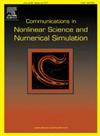基于离散时间状态观测的非周期间歇控制Takagi-Sugeno模糊异质随机延迟网络的准同步
IF 3.8
2区 数学
Q1 MATHEMATICS, APPLIED
Communications in Nonlinear Science and Numerical Simulation
Pub Date : 2025-09-15
DOI:10.1016/j.cnsns.2025.109298
引用次数: 0
摘要
本文深入研究了Takagi-Sugeno模糊异质随机延迟网络(tsfhsdn)的准同步,其中在网络上施加了一种包含时变控制增益的非周期性间歇控制策略,该策略由离散时间状态观测驱动。与现有文献中讨论的间歇控制策略相比,该方法引入了由离散时间状态观测确定的控制区间,提高了控制过程的有效性。值得注意的是,这种基于离散时间状态反馈的间歇控制的非周期性,减轻了传统间歇控制策略的周期性所带来的限制。时变控制增益的引入使控制策略能够实时适应网络的动态特性,从而提高控制的灵活性和有效性。在此基础上,提出了一种鲁棒性强、易于验证的tsfhsdn准同步准则的理论框架。最后,将理论结果应用于弹簧-质量-阻尼器系统,并通过数值算例说明理论结果的实际相关性和有效性。本文章由计算机程序翻译,如有差异,请以英文原文为准。
Quasi-synchronization of Takagi-Sugeno fuzzy heterogeneous stochastic delayed networks by aperiodically intermittent control based on discrete-time state observations
This article delves into the quasi-synchronization of Takagi-Sugeno fuzzy heterogeneous stochastic delayed networks (TSFHSDNs), in which an aperiodically intermittent control strategy incorporating time-varying control gains, driven by discrete-time state observations, is imposed on the networks. Compared with intermittent control strategies discussed in the existing literature, the proposed approach introduces control intervals that are determined by discrete-time state observations, enhancing the efficacy of the control process. Notably, the aperiodic nature of this intermittent control, based on discrete-time state feedback, alleviates the limitations imposed by periodicity that are characteristic of traditional intermittent control strategies. The incorporation of time-varying control gains offers the advantage of enabling the control strategy to adapt to the dynamic characteristics of the networks in real-time, thereby improving the flexibility and effectiveness of the control. Furthermore, the paper presents a robust and easily-verifiable theoretical framework for establishing the quasi-synchronization criterion of TSFHSDNs. Ultimately, the theoretical results are implemented in spring-mass-damper systems, accompanied by a numerical example to illustrate the practical relevance and efficacy of the theoretical findings.
求助全文
通过发布文献求助,成功后即可免费获取论文全文。
去求助
来源期刊

Communications in Nonlinear Science and Numerical Simulation
MATHEMATICS, APPLIED-MATHEMATICS, INTERDISCIPLINARY APPLICATIONS
CiteScore
6.80
自引率
7.70%
发文量
378
审稿时长
78 days
期刊介绍:
The journal publishes original research findings on experimental observation, mathematical modeling, theoretical analysis and numerical simulation, for more accurate description, better prediction or novel application, of nonlinear phenomena in science and engineering. It offers a venue for researchers to make rapid exchange of ideas and techniques in nonlinear science and complexity.
The submission of manuscripts with cross-disciplinary approaches in nonlinear science and complexity is particularly encouraged.
Topics of interest:
Nonlinear differential or delay equations, Lie group analysis and asymptotic methods, Discontinuous systems, Fractals, Fractional calculus and dynamics, Nonlinear effects in quantum mechanics, Nonlinear stochastic processes, Experimental nonlinear science, Time-series and signal analysis, Computational methods and simulations in nonlinear science and engineering, Control of dynamical systems, Synchronization, Lyapunov analysis, High-dimensional chaos and turbulence, Chaos in Hamiltonian systems, Integrable systems and solitons, Collective behavior in many-body systems, Biological physics and networks, Nonlinear mechanical systems, Complex systems and complexity.
No length limitation for contributions is set, but only concisely written manuscripts are published. Brief papers are published on the basis of Rapid Communications. Discussions of previously published papers are welcome.
 求助内容:
求助内容: 应助结果提醒方式:
应助结果提醒方式:


